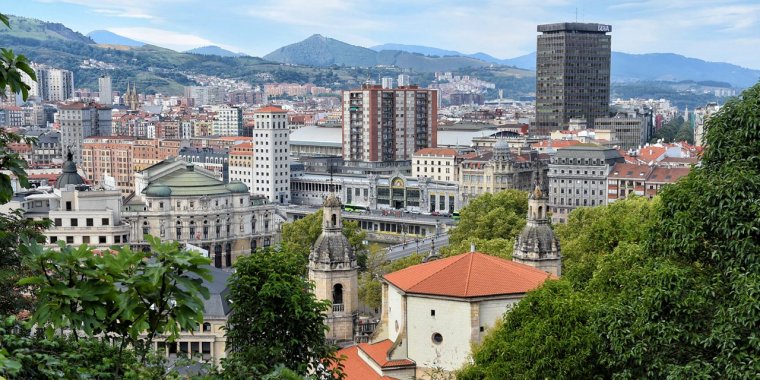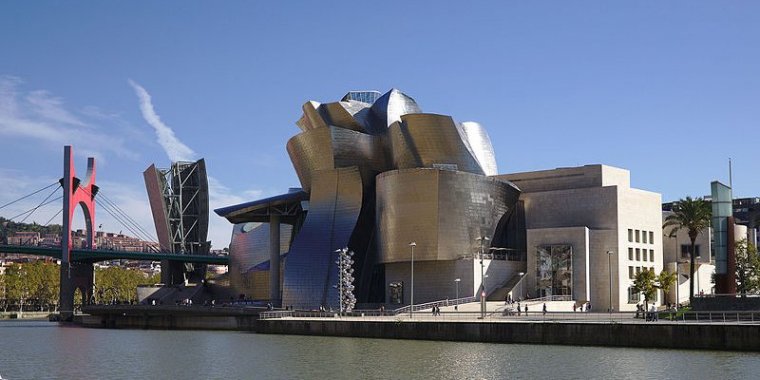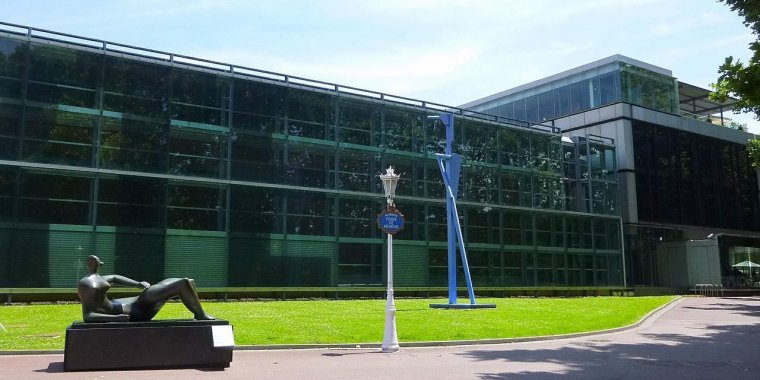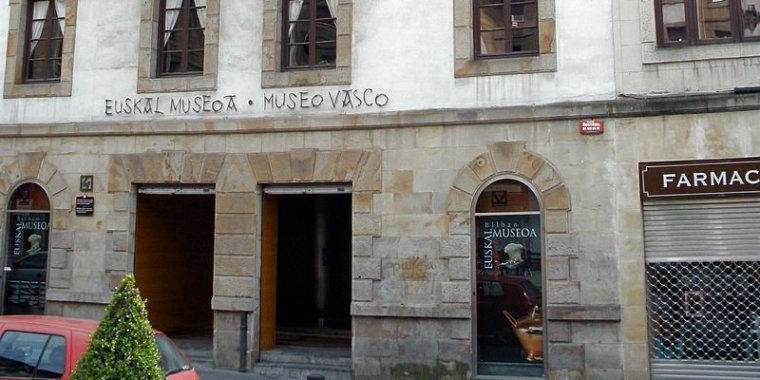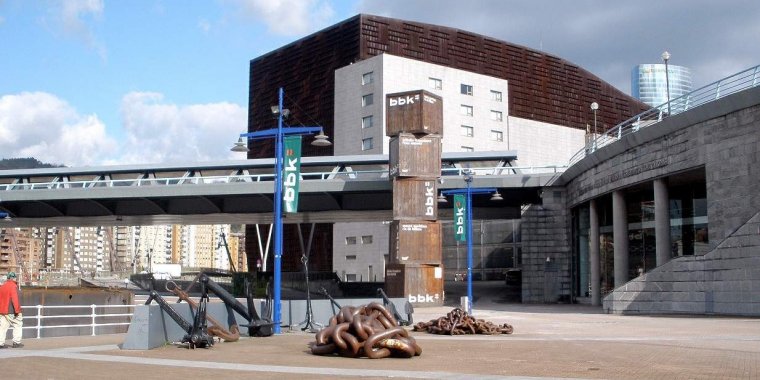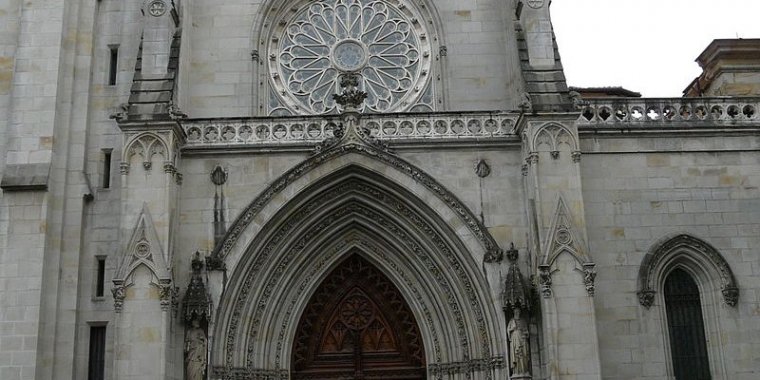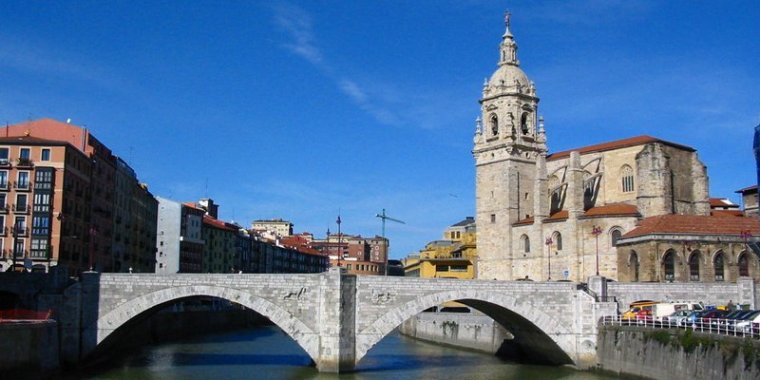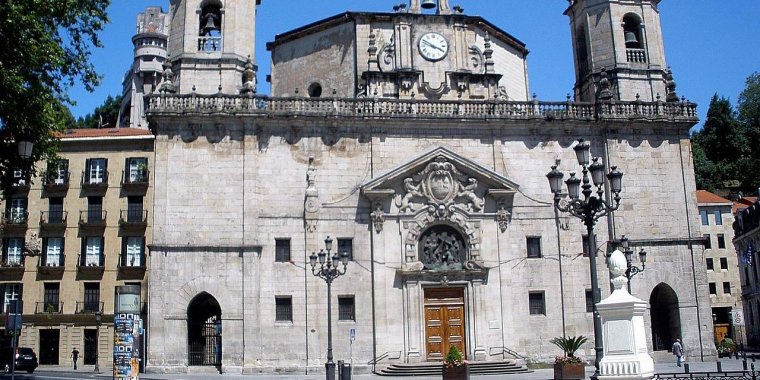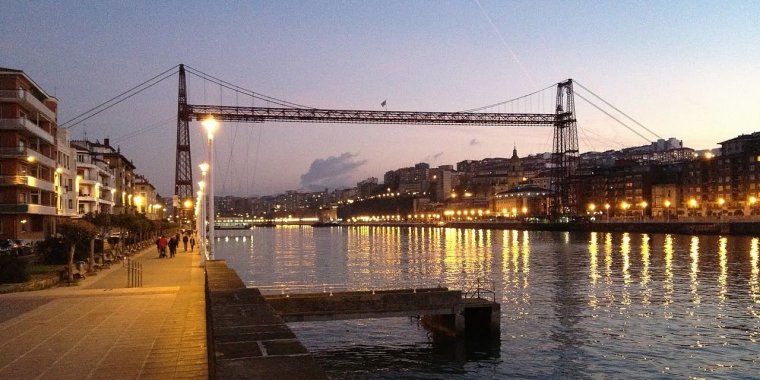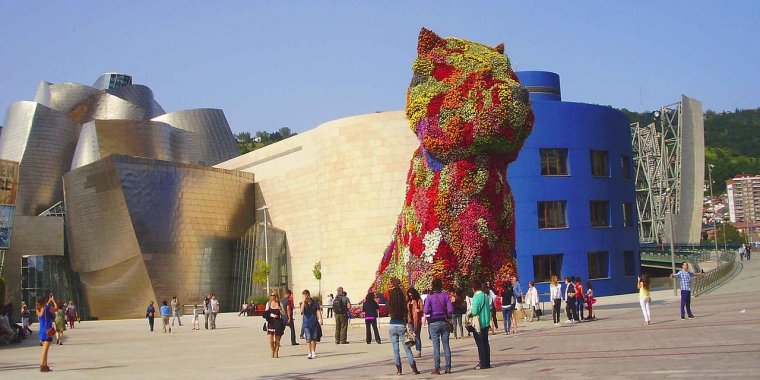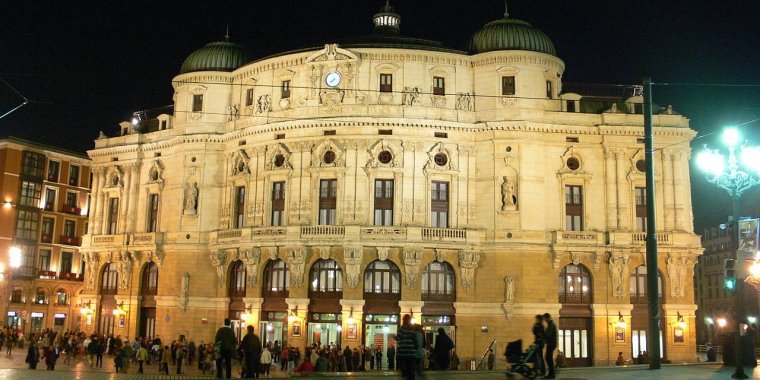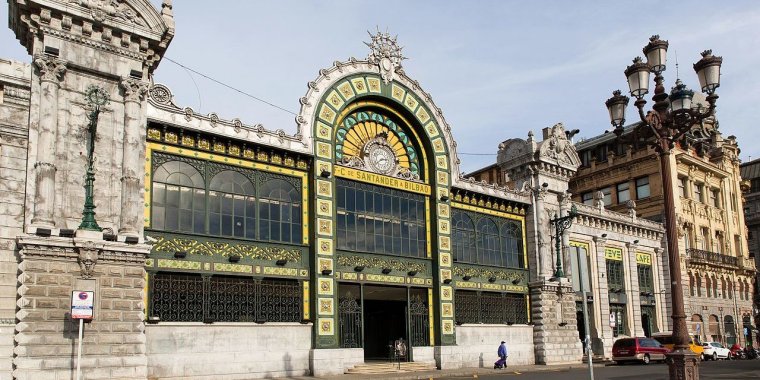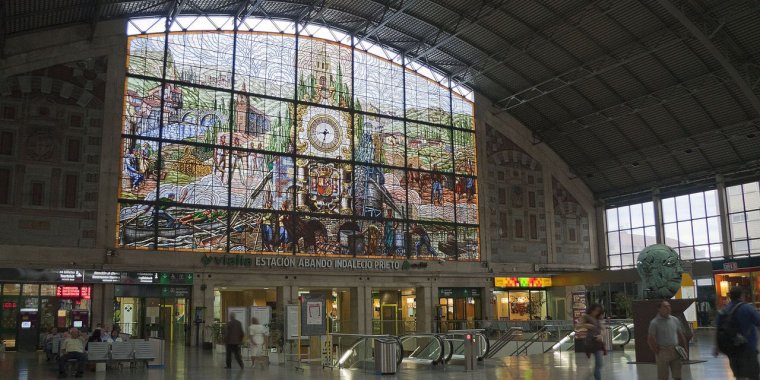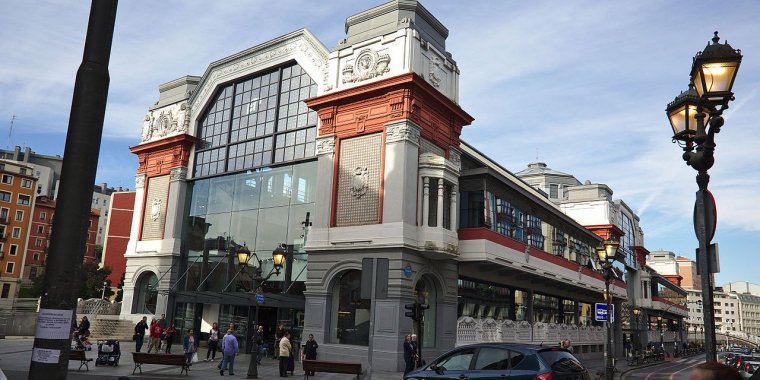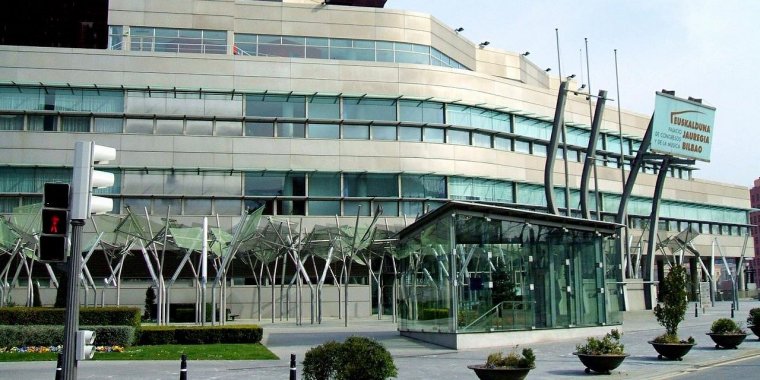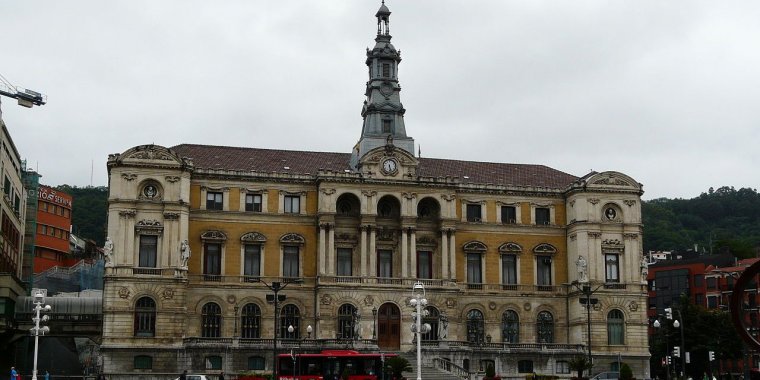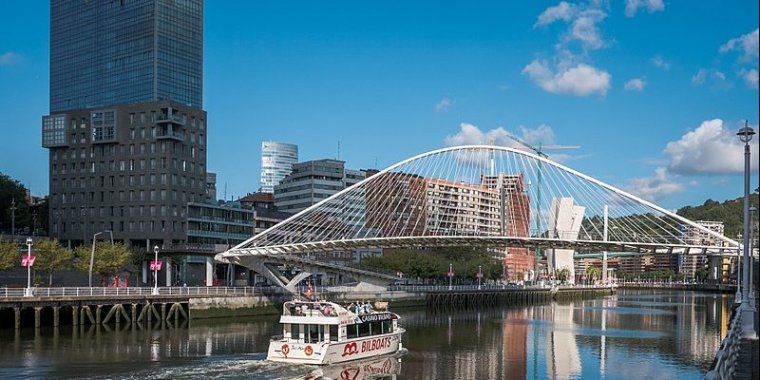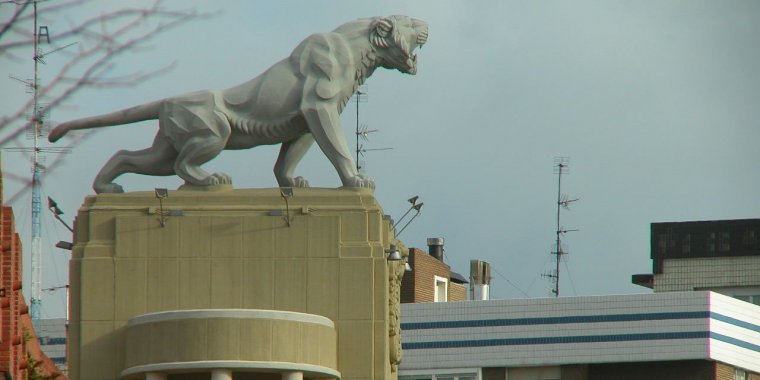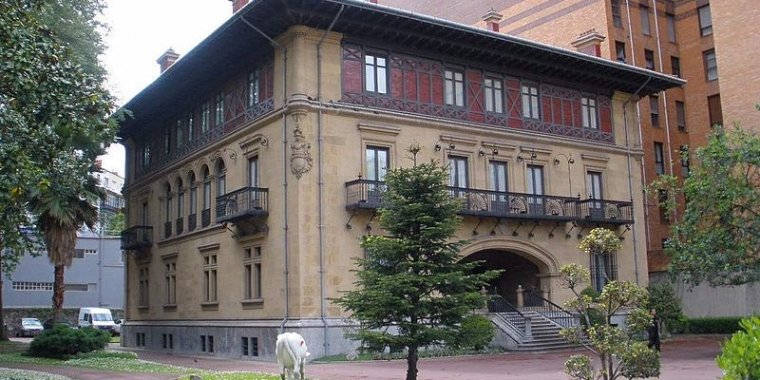| Published in Attractions / Places of Interest |
Tourist Attractions in Bilbao, Spain
Bilbao is perhaps the best place in the world to experience the ancient culture and language of the Basque people, which has stubbornly held its own over thousands of years and is now completely unlike any modern-day culture in Europe.
Museums
• Guggenheim Museum, Abandoibarra etorbidea, 2. Tu-Su 10:00 to 20:00; Jul and Aug: daily 10:00 to 20:00. Closed Jan 1 and Dec 25. Frank Gehry's spectacular twisting titanium-clad modern art museum is perhaps the most celebrated building of the 1990s, even starting what would be called the 'Bilbao-effect': The idea in urban planning that a star-quality building can single-handedly change the entire image of a city. Although this effect is unproven in its pure form, the Guggenheim nevertheless changed the world wide perception of Bilbao.
The graceful, sensuous curves, evocative of the ships that used to be ubiquitous along the docks of Bilbao, are covered in titanium squares, which resemble the scales of a fish and shimmer in the sunlight. In keeping with the maritime theme, appropriate for the setting, the skylights of the largest gallery (formerly known as the Fish gallery) are designed to look like the fins of fish. Many parts of the building are purely decorative, and don't serve any purpose.
The permanent collection is not particularly impressive, but the museum always hosts at least one interesting temporary exhibit, frequently comprised of masterpieces from the other Guggenheim collections. Adults €13.00; students under 26: €7.50; children under 12: free.
• Museo de Bellas Artes (Museum of Fine Art), Plaza del Museo, 2. Tu-Sa 10:00-20:00; Su and public holidays 10:00-14:00; M closed. 1 Jan and 25 December: closed. The Museum of Fine Art's remarkable collection boasts more than 6,000 works dating from the 12th century to the present day, and includes paintings, sculptures, drawings, engravings and decorative objects. General: €6.00; groups, students, senior citizens and unemployed: €4.50. Free of charge on Wed, and for children under 12. Artean Package, €13.50 (tickets for both the Guggenheim Museum and the Fine Arts Museum). Prices change for special exhibitions.
• Basque Museum (Euskal Museoa), Plaza Unamuno, 4. Tu-Sa 11:00-17:00, Su 11:00-14:00. Mondays and public holidays: closed. Established in 1921 to focus on the prehistory, archaeology, ethnography and history of Euskadi (Basque homeland). Not a particularly well laid out museum. It will be of passing interest to people who study Basque culture. Adults: €3; students and groups €1.50. Children under 10 and seniors: free. Th: free.
• La Ría Maritime Museum, Muelle Ramón de la Sota, 1. Winter: Tu-F 10:00-14:00, 16:00-18:00, Sa Su 10:00-14:00 and 16:00-20:00; summer: call to check. It's in what used to be the Euskalduna shipyard, next to the current Euskalduna Performing Arts Center. The museum covers an area of 27,000 m², 7,000 m² for indoor exhibitions and 20,000 m² for outdoor exhibitions, the three docks, the walkway surrounding them and the estuary. Adults: €5; Students, people over 65: €3.50. Children under 6: free of charge.
• Museo Taurino (Bullfighting Museum). Martín Agüero, 1, Plaza de Toros de Vista Alegre, (Near Plaza Zabalburu). Next to a bullring, the Museo Taurino highlights the role bullfighting has played in Euskadi. €3.
• Museo Diocesano de Arte Sacro (Museum of Sacred Art), Plaza de la Encarnación, 9-B, Atxuri. A former convent founded in 1515 by Dominican nuns. General: €2. Students, seniors, and under 18: €1. Free on Thursdays.
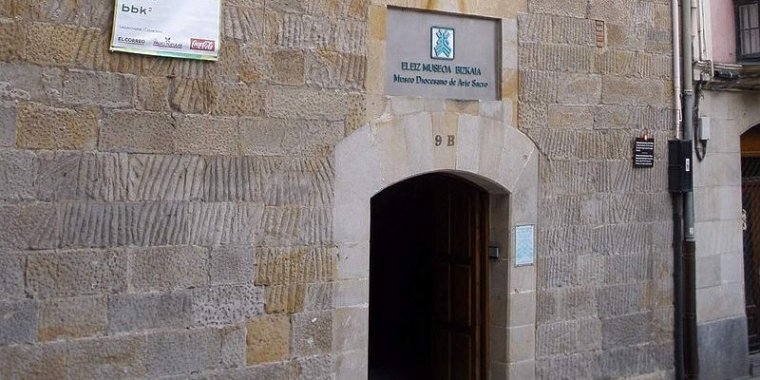
Museo Diocesano de Arte Sacro de Bilbao. ![]()
• Museo de Reproducciones Artísticas (Museum of Artistic Reproductions), Conde Mirasol (no number). Full-scale reproductions of the world's most famous works of art. Call ahead for a guided visit
Churches
• Cathedral of St. James (Santiago). Gothic-style 14th-century cathedral, named after Bilbao's official patron saint. Three naves and small Gothic cloisters. The building was designated a cathedral in 1949. Its Neo-gothic tower and main façade were designed by Severino de Achúcarro in the 1800s. The adjoining square (Plaza de Santiago) bosts a fountain designed by Luis Paret during the reign of Carlos III with the inscription Por el bien público (For the good of the people).
• Iglesia de San Antón. Gothic style church from the first half of the 15th century (1422). Dedicated to San Anton in the 16th century, the building is a mixture of styles including a renaissance portico and baroque tower which was built in 1777. The church was constructed on the ruins of a former alcazar, and is shown on Bilbao's shield.
• Basílica de Begoña, C\ Virgen de Begoña. Overlooking Bilbao, this is perhaps the most symbolic religious building in the city. Built in the 16th-century by Sancho Martinez de Arego, who was also responsible for the Iglesia San Anton. It is a basilica of three naves. During the first Carlista War, in 1835, the façade and the tower were destroyed. The present ones were designed Jose Maria Basterra and constructed between 1902 and 1907.
• Iglesia de San Nicolás, Esperanza, 1 (Arenal, Casco Viejo). The Iglesia de San Nicolás, finished in the 19th century, is dedicated to the patron saint of sailors. One of the best examples of Baroque architecture in Vizcaya.
• Iglesia de San Vicente Martir (Plaza de San Vicente). Gothic church built in the 16th century.
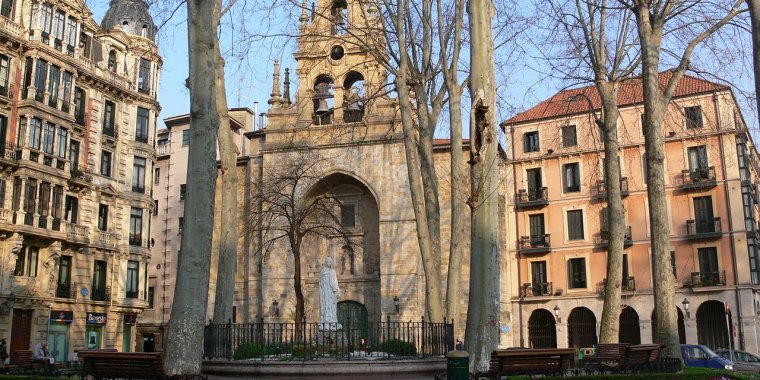
Iglesia de San Vicente Mártir de Abando. ![]()
Other places of interest
• Vizcaya Bridge. Also known as Puente Colgante (the hanging bridge), this is the only UNESCO World Heritage site in Spain listed in the "Industrial" category.
• Alhondiga. An amazing building which has recently modernized (according to designs by Philippe Starck and Thibaut Mathieu). It is an amazing complex containing a library, several bars and restaurants, a cinema and even a roof swimming pool with a glass floor.
• A flower puppy. Just in the front of the Guggenheim Museum, created by Jeff Koons, it's one of the most famous symbols of modern Bilbao Puppy.
• Birthplace of Miguel Unamuno, c/La Ronda 16 (Next to Plaza Unamuno, Metro station: Casco Viejo). Spanish author born on 29 September 1864. His works include the novels Niebla and San Manuel Bueno, Martir, which are both read in AP Spanish Literature classes in the United States. Unamuno died on 31 December 1936 in Salamanca.
• Teatro Arriaga. Inaugurated on 31 May 1890, on the site of several former theaters, the first Teatro Arriaga burnt down on 22 December 1914. The second Teatro Arriaga opened on 5 June 1919. Evocative of the Opera House in Paris, the theater has an ornate façade and beautiful interior. The theater, and the square in front of it, were named after Juan Crosótomo de Arriaga, a composer from Bilbao. There is a tourist information office in the theater building: the entrance is on the left side as you face the theater.
• Estación de Santander (Santander Station, FEVE Station). Also known as La Concordia, it was built between 1898-1902 on the banks of the Nervión. Designed by the engineer Valentín Gorbeña, with the art nouveau main façade added later with a design by the architect Severino Achúcarro.
• Estación Abando (RENFE station) (Next to Santander Station). Even if you are not going to take a train, visit the platforms, there is an impressive stained glass atrium depicting some traditional Basque jobs.
• Puente de San Antón. Next to the Iglesia de San Antón sits Bilbao's most emblematic bridge.
• Mercado de la Ribera. Another emblem next to the Iglesia de San Antón is the Mercado de la Rivera. One of the biggest covered markets in Europe. It was built in 1929 on the site of the original Rivera Street market. Produce fish and meat are sold in the market every morning, except Sundays.
• Plaza Nueva. Bilbao's Plaza Nueva was first named Plaza de Fernando VII. Construction began on the plaza on December 31, 1829 and finished exactly 20 years later on December 31, 1849. This plaza was the seat of the Diputación de Vizcaya until July 1900 when the Diputación moved to its new home on the Gran Vía. The Academy of the Basque Language (Euskaltzaindia) occupies the old Diputación building in the Plaza Nueva. There is a market of used books, stamps, coins, and other small items in the plaza every Sunday morning. The Plaza Nueva is surrounded by buildings and only has entrances on some sides.
• Palacio de la Diputación. Ornately decorated palace situated on the Grand Vía. Baroque-style monument designed by Luis Aladrén in 1897 to serve as the seat of the Diputación Foral de Bizkaia (Vizcaya) and inaugurated on July 31, 1900. The interior is just as lavish as the exterior, with beautiful stained glass windows.
• Palacio Euskalduna. A convention center and concert hall housed in a modern building at the far end of paseo Uribitarte. Home to the Bilbao Symphony Orchestra and Bilbao Opera.
• Plaza Moyua and Gran Vía. On the strech of the Gran Vía between Plaza Abando and Plaza Moyua is the main shopping and fashion district of Bilbao. On this short stretch you can find tons of clothes shops (For, Zara, Mango, H&M) as well as department store El Corte Ingles. This is a must-walk street.
• Parque Etxebarria. The site of a former steel factory, this park was created in the 1980s as the first step of reorienting Bilbao from the industrial sector to the service sector. Wonderful views of the Casco Viejo and the Teatro Arriaga. There is a prominent chimney in the park, left over from the site's time as a factory. The park hosts a fun fair in August.
• Ayuntamiento (City Hall), Plaza Ernesto Erkoreka. Also known as la Casa Consistorial or Udaletxea. The city hall opened in 1892. Designed by architect Jaquin Rucoba in neo-baroque style. Don't miss the main reception area, called Arab Salon.
• Zubizuri. The graceful white pedestrian bridge designed by Santiago Calatrava, actually zubi zuri means white bridge in Basque. It spans the Nervión connecting the riverwalks Campo Volatin and Mazarredo. Be careful, the bridge is slippery when wet.
• El Tigre. Tiger statue on top of a building in Deusto. Seen from Euskalduna Performance Center.
• Bilbao Airport. Curvaceous white 'bird-like' building by Santiago Calatrava. Strangely missing an arrival hall.
• Biblioteca Municipal de Bidebarrieta, Bidebarrieta, 4 (Casco Viejo, near Teatro Arriaga). Commissioned by El Sitio society at the end of the 19th century, this building was built by architect Severino de Achucarro as a social hall. Now home to the city's historical archives and library.
• Palacio de Ibaigane, Alameda Mazarredo, 23. Home to the Athletic Club de Bilbao, Bilbao's football team. Built in the early 20th century. Note the arched entranceway. The nearest metro stop is Moyúa.
• Palacio de Olábarri (Palacete del Puerto Autónomo de Bilbao), Campo Volantín, 37. An interesting mix of several architectural styles. In the late 19th century it was the residence of Bilbaino entrepreneur José María de Olábarri. Now the seat of Bilbao's port authority.
• Santa y Real Casa de la Misericordia, Sabino Arana, 2 (Next to Plaza del Sagrado Corazón). Constructed in the mid-19th century as a charitable house for the poor.
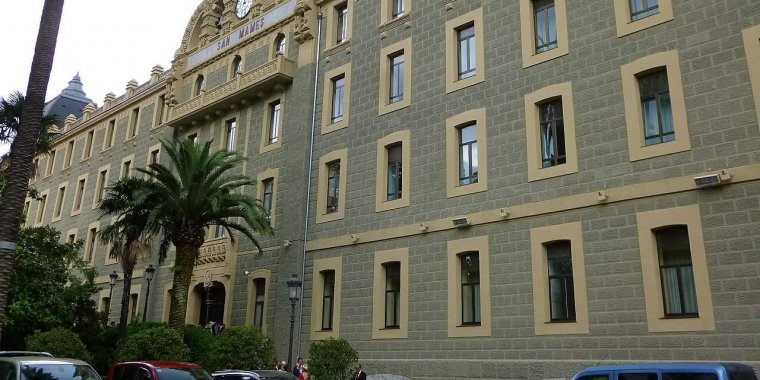
Santa y Real Casa de la Misericordia. ![]()
• In the summer see an open air concert at the Kiosko del Arenal El Arenal Parque (across from Plaza Arriaga). The stage was built in 1923, and renovated in 1985.
• Beginning the first Saturday after August 15 and lasting for 9 days is Aste Nagusia / Semana Grande, the city's fiesta (holiday). An interesting time to come, but be prepared for lots of noise, music, street theater and events, with firework displays in the evening. (Wikivoyage)
See also Bilbao in Pictures.
YOU MAY ALSO LIKE





 If you own or manage a travel-related business such as a hotel, a bed-and-breakfast, a restaurant, a pub or a cafeteria, you can create a web page for your business for free on Titi Tudorancea Travel Info. » |
